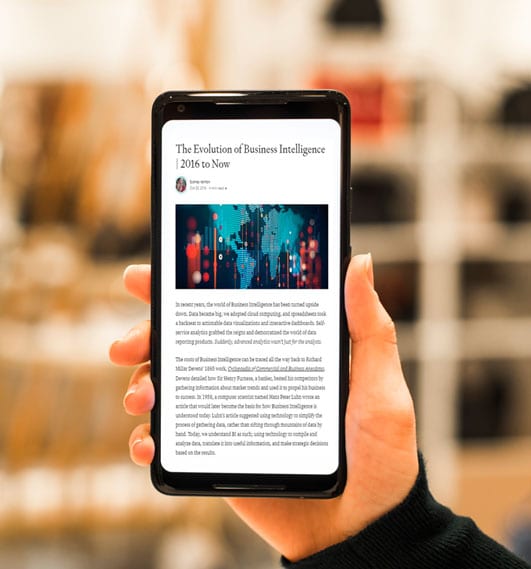In recent years, the world of Business Intelligence has been turned upside down. Data became big, we adopted cloud computing, and spreadsheets took a backseat to actionable data visualizations and interactive dashboards. Self-service analytics grabbed the reigns and democratized the world of data reporting products. Suddenly, advanced analytics wasn’t just for the analysts.
The roots of Business Intelligence can be traced all the way back to Richard Millar Devens’ 1865 work, Cyclopaedia of Commercial and Business Anecdotes. Devens detailed how Sir Henry Furnese, a banker, bested his competitors by gathering information about market trends and used it to propel his business to success. In 1958, a computer scientist named Hans Peter Luhn wrote an article that would later become the basis for how Business Intelligence is understood today.
Luhn’s article suggested using technology to simplify the process of gathering data, rather than sifting through mountains of data by hand. Today, we understand BI as such; using technology to compile and analyze data, translate it into useful information, and make strategic decisions based on the results.
“The BI and analytics market is in the final stages of a multiyear shift from IT-led, system-of-record reporting to business-led, selfservice analytics,” said Rita Sallam, Research Vice President at Gartner. “As a result, the modern business intelligence and analytics (BI&A) platform has emerged to meet new organizational requirements for accessibility, agility and deeper analytical insight.”
The reoccurring trend in next-generation BI tools is that of simplicity. Complex data analysis has become a breeze with the introduction of self-service analytics platforms. Advances in BI technology alleviate the stress and labor hours of gathering, sorting, and using data to make informed business decisions.

2016 BI Trends
Self-service analytics consistently tops the list of BI trend predictions each year. The definition varies from one source to another as self-service tools can be used in many ways. In 2015, Dr. Rado Kotorov, Chief Innovation Officer at Information Builders, compared the evolution self-service analytics to that of an ATM machine.
Kotorov stated, “Just as the ATM in banking evolved from a cashdispensing machine to a full transaction and account management terminal, so too will self-service mature and spread to the masses.”
While self-service analytics took the cake as the most commonly predicted BI trend for 2016, here are a few others:
- Investment in Data Integration
- Growth of Cloud-based BI by 4.5x
- Evolution of Data Governance
- Standalone Mobile Analytics
- Upgraded Data Visualizations
2017 BI Trends
2017 was a major year for the Business Intelligence industry. The cloud was widely adopted due to its advanced security and accessibility. Machine learning increased revenue for businesses by tracking buyer behavior and analyzing databases faster than ever before. AI became more advanced, and trials were run to determine if AI could eventually replace human data scientists altogether.
Projected trends for 2017:
1. Cloud over On-premise- Increased small-medium business revenue by 25% in previous years and accessible anywhere
- Can increase revenue by tracking buyer behavior and analyzing vast databases quickly
2018 BI Trends
In 2018, businesses started searching for the best BI product rather than pondering if the software was necessary or not. Organizations stopped wondering if visualizations improve data analysis but started working out the best way to tell their data stories. Data quality management and embedded BI tools were predicted to become more important than ever. 2018 would be the year of clean and secure information portrayed with a simple and powerful appearance. Multi-cloud tactics and true artificial intelligence were also found at the forefront of this year’s trend predictions.
The Business Application Research Center asked almost 3,000 users, consultants, and vendors for their opinion regarding important BI trends. These survey responses revealed a comprehensive picture of regional, company, and industry-specific differences, and delivered an up-to-date perspective on the BI market. According to the 2018 BARC Trend Monitor, here are the top five most common growth areas:
- Data Quality Management
- Data Discovery
- Self-service BI
- Data Governance
- Data Preparation for Business Users

Sydney Ergle,
08 May, 2019
Sydney Ergle, a graduate from Kennesaw University, is part of SplashBI’s next generation of marketing minds. Sydney oversees SplashBI’s social media, email campaigns, and in her free time likes to hang out with her cat, Tim Beans.








